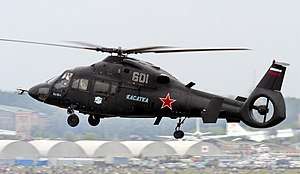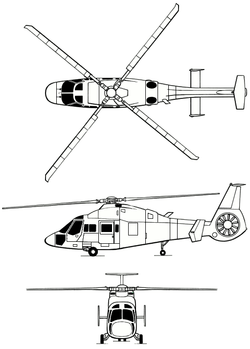Kamov Ka-60
The Kamov Ka-60 Kasatka (Russian: "Касатка", "Barn swallow") is a Russian medium twin-turbine military transport helicopter under development by Kamov. It performed its first flight on 24 December 1998.
| Ka-60 Kasatka | |
|---|---|
 | |
| Kamov Ka-60 prototype at MAKS 2003 | |
| Role | Transport/utility helicopter |
| National origin | Russia |
| Manufacturer | Kamov |
| First flight | 24 December 1998[1] |
| Number built | 2[2] |
The civil version is known as Kamov Ka-62.
Design and development
The Ka-60 has an estimated local military market of 200 units (Army aviation units, Border Police and the Ministry of Internal Affairs). The Ka-60 is to be used for aerial reconnaissance, for transporting air-assault forces, radio-electronic jamming, for special-operations missions and for various light-transport missions. Variations for foreign sale are expected. Manufacture is to take place at Ulan-Ude.
The development of the helicopter was long. The program started in 1984, but the first prototype Ka-60-01 flew in December 1998, and the second in 2007.[3]
A civil version, the Ka-62, was initially proposed when the Ka-60 programme was launched, but no production followed owing to development problems with the Ka-60's Saturn RD-600V 1500 hp engines. Instead, an agreement was signed in April 2011 to use the 1,306 kW (1,751 hp) Turbomeca Ardiden 3G turboshaft for a revised Ka-62. A five-bladed main rotor will be driven via a new transmission, while the helicopter will have a revised cabin with larger windows and new avionics. First flight of the Ka-62 was planned for May 2013, with certification in 2014. Four prototypes and an initial batch of 16 Ka-62s for the Russian Ministry of Defence were planned,[4] with another 12 ordered by South American civilian customers. It has a fantail, a 30-minute run-dry gearbox by Zoerkler, and can operate on one engine up to 9,500 ft (2,900m).[5] Development of the Ka-62, with its western systems and powerplant, has been slow, and the helicopter made several turns over the tarmac on 28 April 2016. On 25 May 2017 it made its maiden flight proper, a 15-minute flight at a speed of up to 110 km/h.[6] Russian certification was expected in 2018, with European EASA certification following in 2020.[7]
Variants
_(cropped)_copy.jpg)
- Ka-60
- Basic multi-role model.
- Ka-60U
- Training version.
- Ka-60K
- Naval version.
- Ka-60R
- Reconnaissance version.
- Ka-62
- New version for the civilian market. It has a redesigned fuselage with a high degree of composites, a larger cabin than the earlier demonstrators and will be equipped with Turbomeca Ardiden 3G engines.[8]
- Ka-64 Sky Horse
- Western certified export version equipped with two General Electric T700/CT7 turboshaft engines and five-blade main rotor.
Operators
_(519-10).jpg)
- Russian Air Force (100 on order)[9][10]
- Atlas Taxi Aereo (7 on order)[11]
- Vertical de Aviación (5 on order)[12]
Specifications

Data from Jane's All The World's Aircraft 2003–2004,[1] Russian Helicopters[8]
General characteristics
- Crew: 1 or 2
- Capacity: 12–15 passengers (Ka-62)
- 14 infantry troops or 6 stretchers
- Internal 2,000 kg (4,409 lb)
- External 2,500 kg (5,512 lb)
- Length: 15.6 m (51 ft 2 in) overall
- Height: 4.6 m (15 ft 1 in)
- Max takeoff weight: 6,500 kg (14,330 lb)
- Powerplant: 2 × Turbomeca Ardiden 3G turboshaftengine, 1,324 kW (1,776 shp) each
- Main rotor diameter: 13.5 m (44 ft 3 in)
- Main rotor area: 143.1 m2 (1,540 sq ft)
Performance
- Maximum speed: 308 km/h (191 mph, 166 kn)
- Cruise speed: 290 km/h (180 mph, 160 kn)
- Range: 770 km (480 mi, 420 nmi)
- Service ceiling: 5,700 m (18,700 ft)
- Hover ceiling: 3,300 m (10,827 ft)
See also
Aircraft of comparable role, configuration and era
- AgustaWestland AW139
- Airbus Helicopters H155
- Bell 430
- Bell UH-1Y Venom
- Eurocopter AS365 Dauphin / Harbin Z-9
- Eurocopter AS565 Panther
- Sikorsky S-76
- Sikorsky UH-60 Black Hawk
- TAI T625
Related lists
References
- Jackson 2003, pp. 373–374.
- Андрей Фомин (2012-05-17). "Новинки HeliRussia 2012" (in Russian). Журнал «Взлёт». Archived from the original on 2012-12-03. Retrieved 2013-01-29.
- Butowski, Piotr. Rosyjskie śmigłowce: kryzys nie mija. Helirussia, Moskwa, 25–27 maja 2017 r., "Lotnictwo Aviation International" Nr. 7/2017, p. 36-37 (in Polish)
- Butowski Air International September 2012, pp. 66–67.
- Mladenov Air International January 2014, p. 74.
- "VIDEO: El primer vuelo del nuevo helicóptero ruso Ka-62", Actualidad RT, 26 May 2017. Retrieved 26 May 2017.
- Mladneov Air International June 2016, pp. 6–7.
- "Russian Helicopters". Archived from the original on 12 March 2016. Retrieved 31 December 2015.
- Kamov Ka-60, warfare.ru, Russian Military Analisis. Retrieved on September 8, 2008.
- "World Air Forces 2013" (PDF). flightglobal.com. Archived (PDF) from the original on 16 December 2012. Retrieved 10 March 2013.
- "Brazil's Atlas Taxi Aereo becomes first export customer for the Ka-62". Flightglobal. 19 December 2012. Archived from the original on 19 March 2013. Retrieved 22 March 2013.
- "MAKS: Russian Helicopters grows backlog for Kamov Ka-62". Flightglobal. 2013-08-29. Archived from the original on 2014-08-08. Retrieved 2013-08-29.
Sources
- Butowski, Piotr. "Russia's Resyled Helicopter". Air International, September 2012, Vol. 82 No. 3. pp. 66–67. ISSN 0306-5634.
- Butowski, Piotr. Rosyjskie śmigłowce: kryzys nie mija. Helirussia, Moskwa, 25–27 maja 2017 r., "Lotnictwo Aviation International" Nr. 7/2017, p. 44–45 (in Polish)
- Jackson, Paul. Jane's All The World's Aircraft 2003–2004. Coulsdon, UK:Jane's Information Group, 2003. ISBN 0-7106-2537-5.
- Mladenov, Alexander. "Kamov's Six Tonne Twin". Air International, January 2014, Vol.86, No. 1. pp. 74–75. ISSN 0306-5634.
- Maldenov, Alexander. "Ka-62". Air International, June 2016, Vol. 90, No. 6. pp. 6–7. ISSN 0306-5634.
- "Nezavisimaya Gazeta", No.241 (1812), 25 December 1998. translation
The initial version of this article was based on material from aviation.ru. It has been released under the GFDL by the copyright holder.